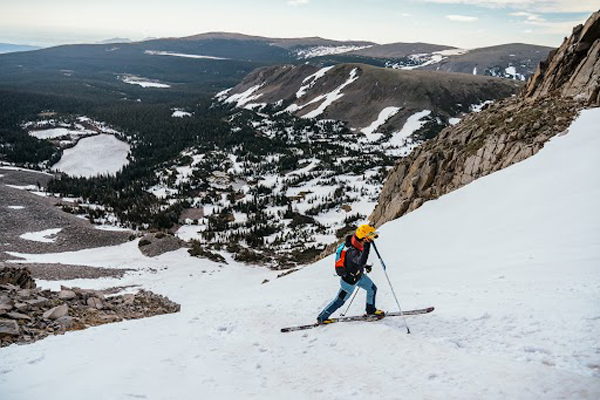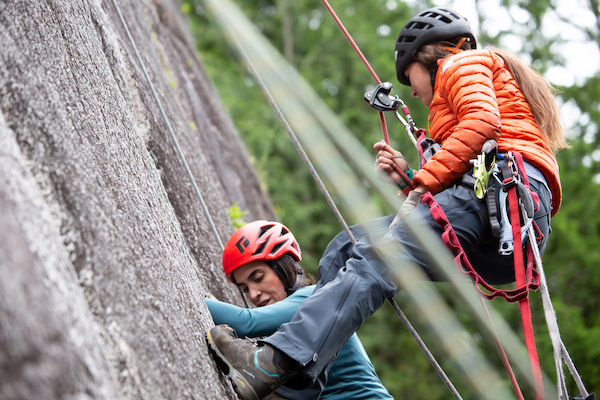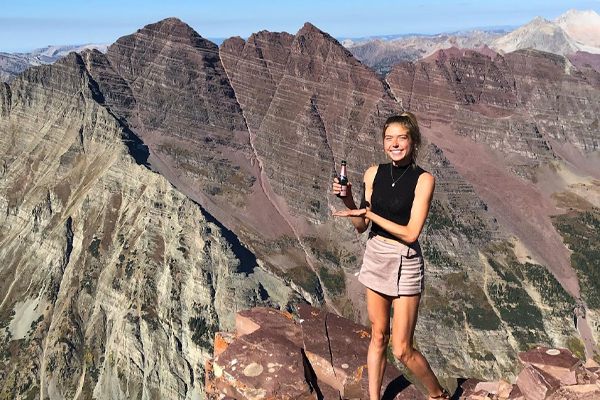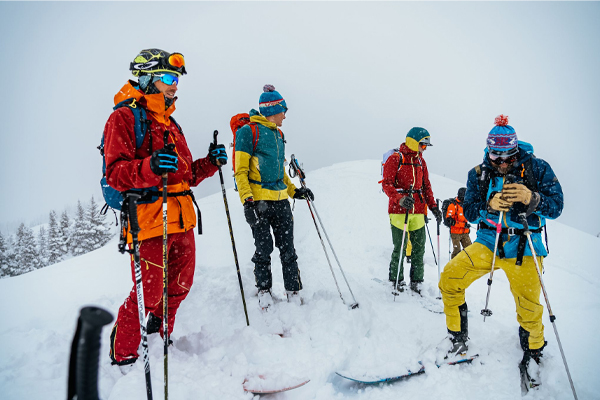Luke Nelson Takes on the Snowman Race


I woke to the sounds of my tent mate gasping for air. The first couple of times it was concerning, unsettling even. As I lay there listening, he would breathe rapidly for a few breaths, then it would slow eventually stopping entirely for up 30 seconds. Several times that night I considered waking him up and making sure he was still alive, and each time as I would shift in my sleeping bag he would gasp and repeat the cycle. Eventually I drifted back to my own fitful sleep, occasionally waking up to my own gasps for air. The next morning we woke and repeated the now familiar rhythm of packing our running packs, heading to the cook tent to try to force down some calories, pass gear and medical checks, then line up with the other remaining runners at the starting line. This is Snowman Race.
The Snowman Race project was initiated in 2018. The King of Bhutan wanted to hold an event that would bring awareness to the impacts of Climate Change on Bhutan and take that information to the rest of the world. A task group was formed of various Bhutanese officials and an international production team lead by famed race director Luis Escobar was brought on board to work with the group to bring the race to reality. A group of 20 international runners and 9 Bhutanese runners were selected to participate. The event was originally planned for 2020, but as with many things, Covid disrupted that plan and delayed the race for 2 years.
On first glance, the race itself didn’t sound like it would be terribly difficult. It would be a 5 day stage race covering around 125 miles total. With an average of 25 miles per day that seemed quite reasonable. Though, upon closer look, the challenge quickly ratcheted up. All runners would be required to carry mandatory gear that would include various clothing layers, water filtration, food and sleeping bags rated for cold temps. This would result in packs ranging between 8-12 pounds. There were no planned aid stations during each day, only a well equipped night halt that would provide a tent, sleeping pad, food and medical coverage. The crown jewel of difficulty came with the altitude; total elevation gain for the race looked to be around 33,000 feet, with an average elevation over 13,000 feet, and high point of the course just a few feet shy of 18,000 feet.
After travel from various locations around the globe, the majority of the international runners were on the same flight from Bangkok, Thailand to Paro, Bhutan. The inflight magazine on the Druk Air flight featured a centerfold article on the Snowman Race. The word spread on the flight that the runners doing the race were passengers and there ended up being a lot of discussion about the race around the cabin.
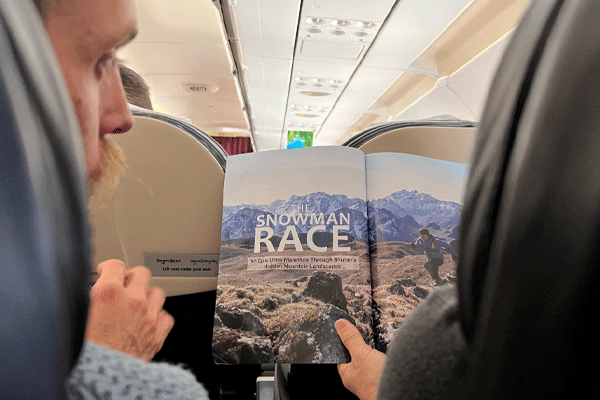
The arrival in the airport and the days that followed leading up the race continued to set the tone of the importance of the race. We were greeted by government officials and Buddhist leaders, blessings and prayers were offered in monasteries and in very official settings, instruction about the race and the impacts of climate change were shared with us. It was made very clear to us that we would have a very important role after the race as ambassadors to the world on behalf of Bhutan to share what we experienced and learned.

After several days in and around the capital city of Thimphu we loaded into vans for the 9 hour drive to Gasa, the start of the race. The full day of travel left us weary, both from the travel itself but also from a prolonged and exciting game of Uno on the bus, hilarious stories and great team bonding amongst all the runners. We arrived after dark and in a heavy rain. Despite the conditions we were welcomed to Gasa by a performance that included dancing to the light of a bonfire in pouring rain by local school children. I find it hard to explain the beauty of the experience. In my experience that weather would have resulted in the program being canceled, but not in Bhutan. They seemed unphased and frankly excited to have a role in this event regardless of the challenge of the weather. It was a good lesson to me about being resilient.

Two more days of preparation in Gasa. We had a few group shakeout runs, medical screenings, education on local wildlife and potential medical issues we could be faced with. We were staying at Gasa Hot Springs, which the year prior had been completely wiped out by a Glacial Lake Outburst Flood (GLOF) event. GLOFs are a results of rapidly melting glaciers. The melted ice forms a lake, often held in place by thinning ice or a moraine. These are prone to failure resulting in devastating and destructive downstream flooding. It was a visceral sight to see the recent destruction of this resort as a result of climate change. Heavy rain continued throughout our stay.

On race morning we started very early and took a short bus ride to Gasa Dzong. As we filtered towards the start we were greeted by the sounds of chanting monks and the smell of incense in the air. After a small, but powerful ceremony we toed the line at the start and began our journey through the Bhutanese Himalaya. We had several miles of dirt road to start out, which was interesting given the already high altitude of 11,000’ and that the road was consistently uphill. The field spread out quite quickly with the Bhutanese runners going off the front surprisingly fast. After the road section we continued up a beautiful river valley on some of the muddiest trail I had ever experienced. For quite some time I ran with Taku from Japan and we laughed at the difficulty of the footing caused by the mud. We moved forward, slipping and sliding as we climbed upward towards the high mountains. About midway we passed a checkpoint staffed by the Royal Bhutan Army. They offered is sliced apples and milk tea and a load of encouragement.

The route continued to climb for several more hours, the mud eventually giving way to steep rocky trails above tree line. Above 15,000’ I struggled to run in the thin air, yet we continued to climb. The night halt location was just above 16,200’, I arrived in 7th place, with the top 5 positions of the day held by the Bhutanse Runners. I felt that I had moved well during the day, but Gawa, who had finished first, was nearly 2 hours faster! Runners would trickle in over the next several hours, many struggling with the altitude.

We woke the next morning to temps in the 20’s but clear skies and amazing views of the high peaks above camp. Most of us had pretty rough nights as a result of the altitude and several runners stopped for medical reasons. When we did start for the day we continued climbing for a couple of miles until we crossed a 17,000’ pass. We then had a 6,000’ descent in to the next river valley. I ran with Gabe Joyes and Simon Mtuy, we reveled in the beauty and the challenging route. As we descended and the air thickened our moods and appetites continued to improve and our pace quickened. The footing was always challenging. At times we were running down rocky stream beds, others we were in very deep slippery mud. It wasn’t fast running but we tried to move efficiently.


After a few hours of descending we began climbing once again as we shifted direction towards the Lunana valley. We would encounter a small village in the late morning that offered us milk tea, mango juice boxes and cookies. Gabe and I sat to enjoy the hospitality before continuing on. Another 16,000’ pass and then another several mile long descent would take us to the community of Lehdi were we were greeted at the finish by dozens of school children waving flags and cheering us in. That evening we gathered around a campfire and enjoyed more dancing in a performance by the school children. It was a wonderful way to cap off a beautiful day.

Another early morning start had us loading packs, trying to get in some of the delicious food, doing gear and med checks and gathering at the in the first light of day. Two more runners would withdraw for medical reasons and later that morning a third. The stop was at 14,000’ but the toll of the altitude was real. The third day was the hardest day of the race. It would end up being 50 kilometers with an extended amount of time above 17,000’ and a high point just shy of 18,000’. Gabe and I again ran together, we relished in the shared experience. We had views of the highest unclimbed peak in the world, and frequently stopped to take photos and videos of the beautiful environment.

We noted huge empty glacial moraines, and were reminded that not long ago those were filled with thick glacial ice that has now retreated at an alarming pace. As we ascended the stops became a bit more frequent as eating while running or walking became too difficult in the thin air and became harder and harder to move quickly. We passed fresh snow leopard tracks as we got to the snow line, and stopped briefly to examine them. In our hazy mental state we unfortunately neglected to take any photos of them.

When we arrived at the pass, and high point of the day, I hung a set of prayer flags that were given to me by a monk at the Tiger’s Nest Monastery. I was told they would bring safety to our group and as I thought of the other runners, my friends, I got quite emotional as I hung them. I am not sure why the tears flowed so easily, perhaps the toll of physical effort, maybe the altitude, maybe all of it opened my soul to the mountains and my friends. I was eventually able to gather myself and after a quick selfie, Gabe and I began would would end up being a several hour descent toward the night stop. This section was the hardest part of the entire race for me. I was struggling with some nausea and had a hard time getting in calories. The night stop was not were we thought it was, and there was a lot of emotion and energy put in to moving forward and solving the challenges of navigation as darkness settled in. When we did finally arrive at camp we were exhausted. I stared at dinner for over an hour before I managed to stuff in some calories and eventually I made my way to my tent for a restless night sleep. My tent mate, Nate Bender, would arrive a few hours later and his breathing, or lack thereof would add to the limited sleep for the night.
The third day was long and challenging for all of the runners. We were granted a late start for the fourth day, and got an extra couple hours of fitful rest. The familiar routine of packing running packs, eating breakfast, medical and gear checks passed and we set out again. The fourth day was on paper the shortest, around 15 miles, but it packed in a ton of vert, something to the tune of 7,000’ of ascending and 8,000’ of descending. There was a lot of mud and no easy running miles. Gabe and I again ran, and walked, together. Midway through the stage we arrived and beautiful river and one of the most amazing hot springs I have ever seen.

It was a bit too hot and we were a bit too pressured for time to soak, so we dipped our fingers, vowed to come back in the future, and set to the task of climbing back up to near 16,000’ over the final pass of the day. When we eventually reached the pass we were able to see the night stop below. It was a beautiful sight! Bright colorful tents on the edge of alpine lake, surrounded by beautiful mountains. The evening had a feeling of celebration. While not guaranteed, it felt like the remaining runners would be able to finish the final stage the next day.

Day four started like the others, but after the start the Bhutanese runners didn’t immediately drop Gabe and I, instead we ran together up the first climb to the high point of the day. We took selfies together and then they took off. Again Gabe and I ran together, it was a beautiful day of running out of the alpine and down in the forest towards the finish. There were some sections of deep mud, but as we got lower the trail improved. With 10 miles to go we got to the end of the road, and were greeted by a large group of school children that waved flags from the countries represented and yelled “Welcome to Bumthang” which is the name of the city the race finished in. This scene repeated itself over and over again as we ran through something like a dozen groups of kids. As we got close to the finish the density of people steadily increased as did our pace. It was overwhelming as we turned the final corner and saw the finish, street lined with people and more than thousand people gathered in a large field cheering at our arrival. It was the most amazing finish line I have ever crossed. We would spend the next several hours at this finish cheering for the other runners. There were performances by children of various ages, performance by a very popular Bhutanese pop artist, and recognition of the runners.

The next morning we returned to the finish area for the awards. Another huge crowd had gathered and it was an outstanding celebration. There were vendors and scientists presenting the results of scientific research on climate change, and selling food and items that were made of recycled plastic or grown locally. The whole feel and energy of the morning was optimistic and joyous. That evening we attended and participated in the Bhutan Climate Conclave. A few of us runners participated and shared what we experienced, there were also scientists, government officials and a message from Her Majesty the Queen. The messaging was clear and concise, climate change is impacting the people of Bhutan, they are working on specific measurable efforts to continue to reduce their impact and imploring the world to join them.

The next two days involved travel back to the capitol, and dinner with the Prime Minister. We had the chance to visit local craft makers and a farmer’s market. The final evening we were invited to a special dinner and had the incredible opportunity to spend some time in person with His Majesty the King and Her Majesty the Queen. They were sincerely interested in our experience, our struggles and successes. Perhaps the most important moment of the entire trip occurred when one of our group asked the King why he wanted trail runners to come to Bhutan and run this race. Not his exact words, but he asked back who better than trail runners, they love nature and depend on it to do what they love to do. They would be able to see the impacts of climate change while moving through the mountains and now have the responsibility to share it with the world. As I traveled home, these words repeated over and over again. Who better than trail runners? Well, that is us. We love running, we love mountains. We are uniquely posed to raise up our communities and know how to do it. There are dozens more experiences that I look forward to sharing about this experience and am grateful for the opportunity to visit Bhutan, run there and share it with all of you!


